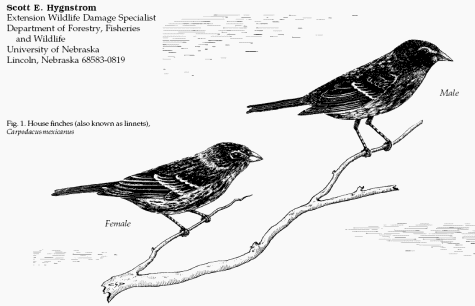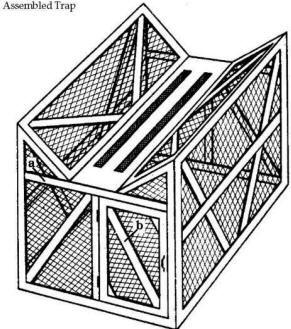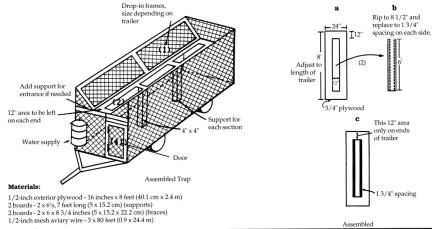|
|
|
|
 |
BIRDS: House Finches |
|
|

Prevention and Control Methods
Exclusion
Cover crops
with plastic netting.
Habitat Modification
Remove cover
used for nesting and resting.
Frightening
Av-Alarms® and
gas cannons have been somewhat effective.
Avitrol®
Repellents
Capsicum
Toxicants
None are
registered or currently available for use.
Trapping
Modified
Australian crow traps, converted cotton trailer trap.
Shooting
Limited
effectiveness.
Identification
House finches (Carpodacus mexicanus, Fig. 1),
also known as linnets, are about the same size as house
sparrows. Males are brownish with a bright red breast,
forehead, rump, and stripe over the eye. They also have
narrow dark stripes on the flanks and belly. Females are
sparrowlike, with a plain head, streaked underparts, and
no eye stripe. House finches have a warbling song,
frequently ending in harsh, nasal notes. Their chirp is
similar to that of a house sparrow.
Range
House finches are abundant residents
throughout the western United States and Mexico. They
are becoming common in the East and are spreading into
the central United States. They are most numerous on the
valley floors and in the foothills of California,
wherever food and water are available. Though house
finches are classified along with other finches as
migratory nongame birds under federal law, authorities
agree that they are relatively nonmigratory. In late
summer they move into the higher mountains and have been
observed at elevations as high as 9,800 feet (3,000 m).
They are generally resident birds and most of those in
valley districts spend their lives within a few miles of
the place where they were hatched.
Habitat
The house finch is most abundant in the warm
valleys of California near cultivated lands. Human
development has created extensive favorable habitat
including hedgerows, field edges, and crop fields.
Food Habits
House finches are primarily seed eaters, and
before the introduction of cultivated fruits, they
probably lived largely on weed seeds. Stomach analyses
by Beal in 1910 indicated that weed seeds totaled 86.2%
of the diet, fruit 10.5%, animal matter 2.4%, and
miscellaneous 0.8%.
General Biology, Reproduction, and Behavior
House finches nest in a
great variety of places. There are few areas in which
they cannot find suitable nesting sites. In the southern
portion of California, nesting begins in March. It
extends to July in colder areas. House finches have
adapted well to the presence of humans. Females will
build nests in almost any sheltered spot, including
eaves and building ledges. Any soft material is used,
including fine twigs and grasses. Four to 5 eggs are
laid and they hatch in 12 to 16 days. Age at first
flight is 11 to 19 days. Two broods are commonly raised,
often in the same nest.
During the nesting period,
adults are widely scattered. As summer progresses,
groups of young birds and a few adults band together to
feed in the general area in which they were reared.
These bands grow larger as additional broods of young
and their parents join them. By mid-August most of the
young are out of the nest and have joined neighborhood
bands. These flocks move about local areas, following
the developmental succession and ripening of fruits and
seeds.
During late August and
well into late autumn, the range of flock movement
increases. By December the birds are generally settled
in areas that offer favorable food and roosting shelter.
They remain in their winter habitat from December until
late February or early March.
Damage and Damage Identification
House finches peck and
feed on practically all deciduous fruits, berries,
grains, vegetable seed, and flower seed. Damage involves
feeding on ripening fruit such as apple, apricot,
avocado, blackberry, cherry, fig, grape, nectarine,
peach, pear, plum, prune, raspberry, and strawberry;
buds of almonds, apricot, nectarine, peach, pear, plum,
and prune; seeds of broccoli, lettuce, milo, and
sunflower; and miscellaneous vegetable, flower, and
tomato plantlets. They also detach the bracts of fruit
buds and eat the buds; at blossom time they knock off
flower petals and eat the embryonic fruits.
Damage occurs to ripening
fruits during three periods:
1. Early season
(damage by nesting adults).
2. Mid to late season (damage by young and adult birds resident in the
locality).
3. Winter (damage to late ripening fruit by flocks of birds gathering in
their winter habitat).
Debudding of fruit trees
can occur in October or November but becomes most
prevalent in January. A relatively small resident flock
of house finches can completely debud considerable
acreage because of their long period of activity. This
damage is typically caused by resident local birds,
wintering birds, or migratory flocks moving from one
range to another.
Legal Status
House finches are
classified as migratory nongame birds in the Code of
Federal Regulations. Depredation permits are required
from the US Fish and Wildlife Service before any control
activities can be initiated. They may be controlled in
California under general supervision of the county
agricultural commissioner.
Prevention
and Control Methods
Exclusion
Install
protective plastic netting (1/2-inch [1.25-cm] mesh) to
protect crops such as blueberries, bushberries, and
strawberries. Although costly, this approach has been
very effective at reducing damage.
Habitat Modification
Remove large
brush piles, stacks of irrigation pipe, and piles of
boxes to eliminate nesting and resting areas for house
finches.
Frightening
Frightening
devices in general have little practical value in
protecting crops from house finches. Good results have
been reported in the use of Av-Alarm® and gas cannons
mounted above the crop and moved frequently. Flags,
dangling papers, aluminum foil, and scarecrows have
little value as methods of crop protection.
Avitrol® Mixed Grain
(0.5%) is a toxic chemical that produces flock-alarming
reactions in birds that ingest a sufficient quantity. It
is currently registered in California to control house
finches in grape vineyards. Six-to 8foot (1.8- to 2.4-m)
V-shaped troughs should be placed 1 to 3 feet (30 to 90
cm) above the vines. Begin prebaiting with untreated
bait (one part Dwarf Essex rape seed and three parts
canary grass seed) when 50 or more house finches are
feeding in the vineyard. Prebait each morning for
several days until maximum feeding activity is achieved.
Clean troughs of prebait
before exposing Avitrol-treated bait. A ratio of two
parts untreated seed to one part treated seed is
recommended. The treated bait should be exposed in the
troughs for 1 to 4 days. Thereafter, the treated bait
should be replaced with clean seed until feeding
activity approaches maximum bait acceptance. The
prebaiting and baiting with treated grain cycle should
be repeated as often as necessary until harvest.
In vineyards, use one
trough per acre (2.5/ha). Smaller vineyards usually
require more troughs per acre than do larger fields.
Bait should be replaced if it becomes water-soaked, or
if depleted by birds, insects, or rodents.
Repellents
Granular
formulations of capsicum repellents are federally
registered for use against house finches and several
other birds. Use is limited to certain fruit, vegetable,
and grain crops. Read the product label for specific
information.
Toxicants
None are registered.
Trapping
Australian crow traps are used to capture crows,
magpies, and ravens. The traps, however, can be modified
by changing the entrance, and used to capture house
finches, crowned sparrows, house sparrows, starlings,
and blackbirds (Fig. 2). Minor modifications can be made
to fit the trap on a truck or trailer. The basic design
of the trap, however, should not be changed. Cotton
trailers can be converted into traps (Fig. 3) and have
been effective in where they can be easily seen. Traps
trapping large numbers of house have been most effective
where birds finches. Use small wire mesh, such as enter
fields and orchards or near rest-1/2 x 1/2-inch (1.2 x
1.2-cm) mesh ing and perching sites. hardware cloth or
aviary wire to cover Trapped house finches serve as
decoys traps used for house finches. to other birds.
Decoy birds are usually Proper trap location is one of
the most essential in attracting other house important
factors in achieving good finches. Use 1 to 15 live
decoys, results. Observe the problem area to depending
on the size of the trap. Pro-determine flyways and
resting, vide food and water in flat containers
perching, and feeding areas before at all times to keep
decoy birds alive placing traps. Place traps in open
areas and to make the trap more attractive

Important Assembly
Instructions
 Place
end panels between side panels; otherwise, top panels
will not fit properly. Note: a. Reinforce this area with
a 2 x 4 x 16-inch (5 x 10.2 x 40.6-cm) piece of wood.
This provides a greater surface area for the entrance to
rest on. b. Place a small door in this area for removal
of trapped birds. Materials Needed For Trap: 15 boards -
1 x 4’s, 8 feet long (2.5 x 10.2 cm, 2.4 m long) 25
boards - 1 x 4’s, 6 feet long (2.5 x 10.2 cm, 1.8 m
long) 4 boards - 1 x 1’s, 8 feet long (2.5 x 2.5 cm, 2.4
m long) 1/2-inch exterior plywood - 16 inches x 8 feet
(40.1 cm x 2.4 m) 1/2-inch mesh aviary wire - 3 x 80
feet (0.9 x 24.4 m) 2 hinges staples Place
end panels between side panels; otherwise, top panels
will not fit properly. Note: a. Reinforce this area with
a 2 x 4 x 16-inch (5 x 10.2 x 40.6-cm) piece of wood.
This provides a greater surface area for the entrance to
rest on. b. Place a small door in this area for removal
of trapped birds. Materials Needed For Trap: 15 boards -
1 x 4’s, 8 feet long (2.5 x 10.2 cm, 2.4 m long) 25
boards - 1 x 4’s, 6 feet long (2.5 x 10.2 cm, 1.8 m
long) 4 boards - 1 x 1’s, 8 feet long (2.5 x 2.5 cm, 2.4
m long) 1/2-inch exterior plywood - 16 inches x 8 feet
(40.1 cm x 2.4 m) 1/2-inch mesh aviary wire - 3 x 80
feet (0.9 x 24.4 m) 2 hinges staples
Fig. 2. Modified
Australian crow trap.

Fig. 3. Below Converted
cotton trailer trap. to captured birds. Canary grass
seed, wild bird seed mix, or chick scratch (cracked
corn, milo, and other grains) work well to maintain
decoy birds. Install 1/4-inch (0.6-cm) dowel rods to
serve as perches, especially in larger traps. Perches
should run the full length of the trap, and be located
about 1 foot (30 cm) from the sides and halfway between
the top and the bottom of the trap. Cold winds or hot
sun can stress trapped birds. Fasten burlap to the sunny
side of the trap to provide shade in the summer. Birds
can be removed from modified Australian crow traps by
catching them with your hand or a small net. Several
birds can be removed by cutting a 6 x 6-inch (15 x
15-cm) exit hole that is easily opened and closed in an
upper corner of the rear of the trap. Place a small
holding cage on the outside of the trap over the open
exit hole and herd the birds from the trap into the
holding cage. To euthanize the birds, place the holding
cage in a plastic bag and inject carbon dioxide through
a hose until the birds are dead. Burn or bury the dead
birds. Shooting Shooting will somewhat reduce the<
number of birds present but is a costly and rather
futile method of crop protection.
Acknowledgments
Figures 1, 3, and 4 are
reproduced from Clark (1986). Figure 2 was adapted from
Robbins et al (1983) by David Thornhill, University of
Nebraska-Lincoln.
For Additional Information
Beal, F. E. L. 1910. Birds of California in relation to
the fruit industry. Pages 13-23 in Biol. Survey Bull.
No. 30. US Dep. Agric.
Clark, J. P. 1986.
Depredating birds. Pages 701-1 - 726-1 in J. P. Clark,
ed. Vertebrate pest control handbook. Calif. Dep. Food
Agric. Sacramento.
Palmer, T. K. 1970. The
house finch and starling in relation to California’s
agriculture. Pages 265-277 in Proc. of general meeting
of the work group on granivorous birds. The Hague,
Holland.
Palmer, T. K. 1970. House
finch (linnet) control in California. Proc Vertebr. Pest
Conf. 4:173-178.
Peterson, R. T. 1961. A
field guide to western birds. Houghton Mifflin Co.
Boston. 309 pp.
Robbins, C. S., B. Brunn,
and H. S. Zim. 1983. Birds of North America. Golden
Press. New York. 360 pp.
Editors
Scott E. Hygnstrom Robert
M. Timm Gary E. Larson
PREVENTION AND CONTROL OF
WILDLIFE DAMAGE — 1994
Cooperative Extension
Division Institute of Agriculture and Natural Resources
University of Nebraska -Lincoln
United States Department
of Agriculture Animal and Plant Health Inspection
Service Animal Damage Control
Great Plains Agricultural
Council Wildlife Committee
04/05/2006
Special
thanks to:
Clemson University
|